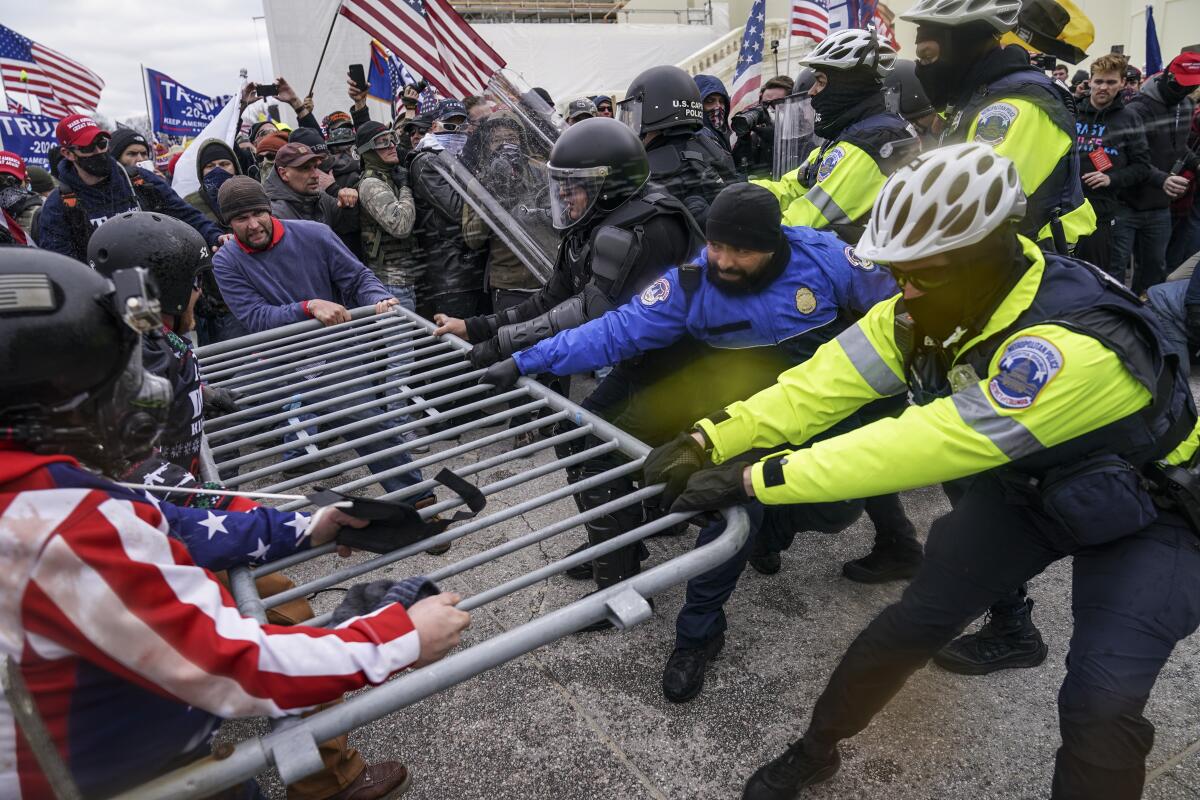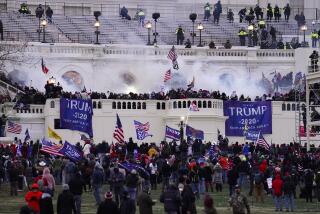In Trump’s Jan. 6 recast, attackers become martyrs and heroes

- Share via
WASHINGTON — A cocktail of propaganda, conspiracy theory and disinformation — of the kind intoxicating to the masses in the darkest turns of history — is fueling straight-up delusion over the agonies of Jan. 6.
Hate is “love.” Violence is “peace.” The pro-Donald Trump attackers are patriots.
Months after the then-president’s supporters stormed the Capitol that winter day, Trump and his acolytes are taking this revisionism to a new and dangerous place — one of martyrs and warlike heroes, and of revenge. It’s a place where cries of “blue lives matter” have transformed into shouts of “f— the blue.”
The fact inversion about the siege is the latest in Trump’s contorted oeuvre of the “big lie” compendium, the most specious of which is that the election was stolen from him. It was not.
It is rooted in the basic formula of potent propaganda through the ages: Say it loud, say it often, say it with the heft of political power behind you, and people will believe. Once spread by pamphlets, posters and word-of-mouth, now spread by the swipe of a finger, the result is the same: a passionate, unquestioning following.
Techniques of glorifying your side and demonizing the other with skewed information, if not outright lies, have been in play at least since World War I, when the U.S. government roused sentiment for the cause with posters depicting the German soldier as an ape-human with an American maiden in his clutches. That paled next to what followed years later with Nazi Germany’s terrifying use of propaganda for the slaughter and subjugation of millions.
Whether the deception feeds warmongering or merely a defeated president’s ego, some of the methods are the same, like telling the same fabrication over and over until it sticks.
Trump perfected the art of repetition — about the “election hoax,” the “rigged election” and ”massive voter fraud,” with none of those accusations substantiated but engrained nonetheless among his supporters.
Four years ago, Trump appeared to equate white supremacists and racial justice protesters in Charlottesville, Va., with his comment that there were “very fine people, on both sides.”
This time, in this telling, the very fine people on Jan. 6 were on one side: his.
For the other side — the police, overwhelmed for hours and beaten in the insurrection — Trump only has an in-your-face question that doubles as a four-word conspiracy theory: “Who killed Ashli Babbitt?”
Those words have become a viral mantra meant to elevate Babbitt as a righteous martyr. They ricochet around the mainline social media platforms where Trump is banned for spreading misinformation but his followers still commiserate. The woman died from a police officer’s bullet fired as she tried to climb through the jagged glass of a smashed window toward the House chamber.
Trump and many Republicans have cycled through various characterizations of the insurrection, each wholly unlike the previous one. The attackers were said to be leftist antifa followers in disguise. Then were said to be overexcited tourists. Now they are heralded as foot soldiers for freedom.
Each iteration has required Americans to ignore the rage they saw on their screens, and some lawmakers to ignore that they were among the shocked targets of the attackers that day.
The revisionists and their believers are “swimming in a vast sea of nonsense,” said Brendan Buck, a former top aide to House Speaker Paul Ryan.
That sea’s currents are familiar to historians.
Once people buy into the lies, there can be no convincing them they aren’t true, said Dolores Albarracín, a psychology professor at the University of Pennsylvania and co-author of a coming book, “Creating Conspiracy Beliefs: How Our Thoughts Are Shaped.”
Believers often dismiss anyone who tries to set them straight by claiming they are either duped or part of the conspiracy, Albarracín said.
“The belief contains a device that protects it,” she said. “Nothing can invalidate the conspiracy theory. Trying to refute the theory proves the theory and signals you as a conspirator.”
Recent polls illustrate the country’s divide over Trump and his post-election histrionics. In essence, two-thirds of the population is against him, with two-thirds of Republicans for him. In one of the latest, Quinnipiac found that 66% of Republicans considered President Biden to have been illegitimately elected.
That number and others like it in multiple polls represent tens of millions of people who were hoodwinked into believing allegations of election fraud that have been thoroughly investigated and refuted. Trump’s fabrications have stuck and now undergird the attempts by him and those closest to him to glorify the Jan. 6 mob.
“The consequence of lying is you kind of never get back to where you were before,” said Harvard historian Jill Lepore, whose podcast, “The Last Archive,” explores hoaxes, deceptions and what has happened to truth. “That’s what’s pernicious about our particular moment.”
Of Trump, she said: “His method is generally to just create chaos so that people really don’t know which way to look.”
In the case of the insurrection, his followers looked away. An aggressive amnesia seems to have taken hold over how ugly it was.
Swarming to the Capitol after a staging rally where Trump told them to “fight like hell,” the attackers injured scores of the outnumbered law enforcement officers.
Babbitt was part of the group that was trying to beat down the doors of the House chamber as Capitol Police officers were evacuating the House floor and as some members were still trapped in the upper gallery. The officers used furniture to barricade the glass doors separating the hallway from the Speaker’s Lobby to try to stave off the attackers, who were breaking glass with their fists, flagpoles and other objects.
Only three police officers were guarding the doors against at least 20 attackers. A Capitol Police lieutenant pointed his gun as hysteria reached a fever pitch. Attackers started to lift Babbitt up to climb through the jagged window. The officer fired one round.
Babbitt was struck in the shoulder. She later died.
Trump now states falsely, and repeatedly, that she was shot “right in the head.”
More to Read
Sign up for Essential California
The most important California stories and recommendations in your inbox every morning.
You may occasionally receive promotional content from the Los Angeles Times.










